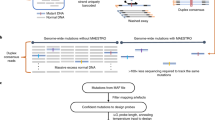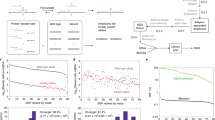Abstract
To exploit contemporary sequencing technologies for targeted genetic analyses, we developed a hybridization enrichment strategy for DNA capture that uses PCR products as subgenomic traps. We applied this strategy to 115 kilobases of the human genome encompassing 47 genes implicated in cardiovascular disease. Massively parallel sequencing of captured subgenomic libraries interrogated 99.8% of targeted nucleotides ≥20 times (∼40,000-fold enrichment), enabling sensitive and specific detection of sequence variation and copy-number variation.
This is a preview of subscription content, access via your institution
Access options
Subscribe to this journal
Receive 12 print issues and online access
$259.00 per year
only $21.58 per issue
Buy this article
- Purchase on Springer Link
- Instant access to full article PDF
Prices may be subject to local taxes which are calculated during checkout



Similar content being viewed by others
References
Maron, B.J. et al. Circulation 92, 785–789 (1995).
Alcalai, R., Seidman, J.G. & Seidman, C.E. J. Cardiovasc. Electrophysiol. 19, 104–110 (2008).
Hovingh, G.K. et al. Curr. Opin. Lipidol. 16, 139–145 (2005).
Willer, C.J. et al. Nat. Genet. 40, 161–169 (2008).
Kim, J.B. et al. Science 316, 1481–1484 (2007).
Hillier, L.W. et al. Nat. Methods 5, 183–188 (2008).
Chiang, D.Y. et al. Nat. Methods 6, 99–103 (2009).
Goossens, D. et al. Hum. Mutat. 30, 472–476 (2009).
Lovett, M. Curr. Protoc. Hum. Genet. 6.3 (2001).
Bashiardes, S. et al. Nat. Methods 2, 63–69 (2005).
Albert, T.J. et al. Nat. Methods 4, 903–905 (2007).
Gnirke, A. et al. Nat. Biotechnol. 27, 182–189 (2009).
Porreca, G.J. et al. Nat. Methods 4, 931–936 (2007).
Bentley, D.R. et al. Nature 456, 53–59 (2008).
Moore, D. & Dowhan, D. Curr. Protoc. Mol. Biol. 2.1A (2002).
Parnes, J.R. et al. Proc. Natl. Acad. Sci. USA 78, 2253–2257 (1981).
Brown, T. Curr. Protoc. Mol. Biol. 2.9B (2001).
Rees, W.A., Yager, T.D., Korte, J. & von Hippel, P.H. Biochemistry 32, 137–144 (1993).
Li, H., Ruan, J. & Durbin, R. Genome Res. 18, 1851–1858 (2008).
Kharchenko, P.V., Tolstorukov, M.Y. & Park, P.J. Nat. Biotechnol. 26, 1351–1359 (2008).
Acknowledgements
We thank J. Aach, J. Gorham, J. Kim, J.B. Li and L. Wang for helpful discussions and advice; J. Kastelein and J.A. Kuivenhoven for HDL subject genomic DNA and for assistance in selecting HDL target genes; S. Depalma for analysis of Affymetrix custom sequencing array data; L. Merrill and D. Sonkin at Partners Center for Personalized Genetic Medicine of Harvard Medical School for Illumina sequencing and support; B. Richter, D. Gurgul, S. Roylance, J. Xu and A. Zschau at Partners Healthcare for access to high-performance computing cluster and data storage; T. Levi and B. McDonough for subject recruitment and genomic DNA isolation; S. Cox and M. Iaculli for generating HCM amplimers; and members of the Drosophila RNAi Screening Center for access to their Molecular Devices Analyst GT plate reader. G.K.H. was supported by grants from the Dutch Heart Association (NHS 2007R001) and Saal van Zwanenbergstichting. This work was supported by grants from the National Cancer Institute, the National Heart, Lung and Blood Institute, the Howard Hughes Medical Institute, and the Leducq Foundation.
Author information
Authors and Affiliations
Contributions
D.S.H., G.K.H., J.G.S. and C.E.S. conceived and designed the study; D.S.H. and G.K.H. constructed libraries and target concatemers; D.S.H. analyzed sequence data; O.I. and R.K. sequenced the libraries; H.L.R., D.S.H. and R.K. designed and amplified HCM sequences; D.S.H., J.G.S. and C.E.S. wrote the manuscript.
Corresponding author
Supplementary information
Supplementary Text and Figures
Supplementary Figures 1–9, Supplementary Tables 1–7 and Supplementary Methods (PDF 5040 kb)
Rights and permissions
About this article
Cite this article
Herman, D., Hovingh, G., Iartchouk, O. et al. Filter-based hybridization capture of subgenomes enables resequencing and copy-number detection. Nat Methods 6, 507–510 (2009). https://doi.org/10.1038/nmeth.1343
Received:
Accepted:
Published:
Issue Date:
DOI: https://doi.org/10.1038/nmeth.1343
This article is cited by
-
High-sensitivity HLA typing by Saturated Tiling Capture Sequencing (STC-Seq)
BMC Genomics (2018)
-
New Approaches in Detection and Treatment of Familial Hypercholesterolemia
Current Cardiology Reports (2015)
-
High-throughput sequencing of microdissected chromosomal regions
European Journal of Human Genetics (2010)
-
Increasing phylogenetic resolution at low taxonomic levels using massively parallel sequencing of chloroplast genomes
BMC Biology (2009)



